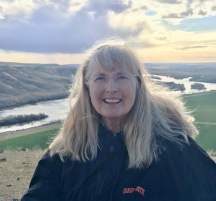No products in the cart.
Cougar!

Down on the Farm
By Diana Hooley
My husband and I drink our morning coffee in a nook surrounded by large windows that face the Snake River. We see the sun rise over the river: the dreary winter suns and the movie star-like summer suns. As dawn approaches, reeds and willows on the river bank become dark silhouettes.
One morning not long ago, a new silhouette appeared. It was moving slowly, about thirty feet away.
“What is that?” I said to my husband as I pointed out the window.
Dale gasped. “That’s a cougar!”
With Idaho’s burgeoning population and growing cities and recreational areas, it’s easy to forget we still live in a wild state with wild creatures. Living rurally as I do in the Hammett area, I’ve had my share of encounters with rattlesnakes, raccoons, and coyotes.
Once on a hike I even saw a bobcat that observed me curiously before leaping up the hill [see “Lost to the World,” IDAHO magazine, April 2019]. But in the forty-five years I’ve lived here, I had never seen a cougar.
Cougar (or mountain lion) sightings are very rare. They are reclusive animals, and their numbers are not robust, with only about two thousand cougars in our entire state. They’re largely nocturnal, sleeping most of the day. The one my husband and I saw was big. Dale said it probably weighed at least 150 pounds. Cougar eat deer and other ungulates or hoofed mammals.
When I first saw the cougar out the window, I thought it was a huge dog. But unlike a dog, its head was square, its snout blunt, and its ears small. We were both stunned by the sight of such a magnificent creature. I thought about taking a picture but didn’t want to stop watching the big cat long enough to search for my cell phone.
Eventually, it moved out of view, and we decided to try to follow it in our pickup. Incredibly, the cougar padded right past our sleeping dog. Milo only roused himself when he heard the pickup start, and then he jumped into the truck bed to ride along with us.
We went bouncing down the gravel field road in the weak morning light, our headlights shining, looking for our prey, who wasn’t prey at all. Cougars are apex predators, at the top of the food chain. They eat other animals—other animals don’t eat them.
Unsurprisingly, for a good while after this sighting, both my husband and I were hesitant to venture outside in the dark.
We drove the pickup past our machine shop and were almost at the corral when Milo leaped out of the truck and raced over to the riverbank.
“He’s finally smelled the cat,” Dale said.
I was a little worried about Milo but there wasn’t much we could do. He’s a farm dog who won’t be penned in. Besides, Milo’s got great survival instincts, and he’s never been much of an alpha guard dog. Dale called to him and Milo trotted back into sight. All three of us waited from the safety of the pickup, hoping to catch another glimpse of the cougar—but it was not to be.
The next few days, Dale and I looked for signs of the mountain lion. He noticed some unusual animal droppings that could be the cougar’s, or perhaps it was some other animal. I took a walk and went to sit on a patch of tall grass near the river.
In the middle of the patch, the grass was matted, as if a big animal had bedded down there. I swept my hand over the mat and wondered at all the wild animals who passed through our farm and claimed it as their stalking ground, or even their home.
This content is available for purchase. Please select from available options.
Purchase Only
Purchase Only

